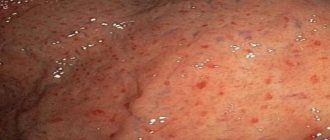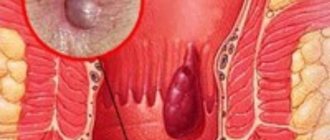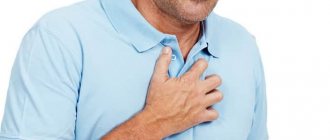Symptoms
For attacks accompanied by painful sensations in the epigastric region, the following symptoms are characteristic:
- Feeling of fullness in the stomach, regardless of the amount of food eaten.
- Burning in the chest and throat after eating. This symptom is especially pronounced if the diet included fatty, fried, sour or salty foods, smoked meats, sausages, chocolate and coffee in large quantities.
- Dull, aching or sharp, sharp pain in the area located between the chest and abdominal cavity.
Sometimes an exacerbation is accompanied by additional symptoms, such as hiccups, nausea, partial regurgitation of food, vomiting, belching, bloating, and an unpleasant taste in the mouth.
Treatment
Only a qualified doctor can prescribe medications for heartburn and stomach pain. Self-administration of medications will aggravate the condition and cause complications. The therapy involves a specific scheme, doctors prescribe to patients:
- Antibiotics. Medicines help with the development of gastritis or ulcers if the causative agent of the pathology is Helicobacter pylori bacteria.
- Antacids. Helps reduce the acidity of gastric juice. This is one of the main conditions in the treatment of pathologies of the digestive system. Also, these drugs heal the resulting damage to the mucous membranes.
- Blockers. Medicines needed to reduce the production of hydrochloric acid.
- Prokinetics. Means that help restore wall peristalsis. Thanks to the improved tone of the esophageal sphincter, gastric emptying occurs faster, therefore reducing the risk of its contents entering the esophagus.
- Vitamin complexes.
- Antispasmodics.
If a patient has severe heartburn, the doctor must prescribe a special diet. This is part of the therapy in which the patient should avoid spicy, fatty foods. Any fast food or carbonated drinks are prohibited. It is important to eliminate bad habits such as smoking and drinking alcohol.
Heartburn and stomach pain should not be left without intervention. This may be a minor illness or a symptom of a serious illness. It is recommended to undergo a full medical examination. Some drugs only help relieve symptoms, but it is necessary to treat the underlying pathology.
Heartburn is a symptom so common that even people who do not suffer from diseases of the digestive system are familiar with the burning sensation in the chest.
An attack of heartburn can suddenly appear in a healthy person after overeating, drinking large amounts of alcohol, or low-quality or spoiled foods.
An unhealthy lifestyle and poor diet with excess fat, fried foods, confectionery, and baked goods leads to increased and more frequent attacks.
If severe heartburn often occurs, what should you do to get rid of it?
Causes
The immediate cause is weakening of the cardiac sphincter muscles, which prevents the return of food from the stomach to the esophagus, as well as disruption of the normal functioning of the stomach. One of the following factors can also provoke this condition:
- increased acidity of gastric juice;
- excessive consumption of spicy, fried, salty, sour, smoked foods (citrus fruits, tomatoes, sorrel, sour apples, plums);
- coffee, chocolate, strong black tea, brown bread, pastries;
- lack of a diet: eating dry foods, too hastily, on the go, with long time intervals;
- obesity;
- hormonal changes during pregnancy;
- smoking, alcohol abuse;
- taking certain types of medications (aspirin, ortofen, ibuprofen);
- hot food;
- large portions of food eaten less than 1-1.5 before bedtime;
- lifting weights soon after eating;
- Abdominal tightening clothing.
Important information! The symptoms cannot be ignored, as they may be the first signs of a chronic disease of the digestive tract.
If you regularly experience a burning sensation in the solar plexus area, accompanied by pain, you should be examined by a gastroenterologist. If necessary, for a more detailed consultation, the patient can be redirected to an oncologist, toxicologist, or infectious disease specialist.
Diseases that cause heartburn
In addition to external causes, there are internal factors that provoke the appearance of corresponding symptoms - these are diseases of the gastrointestinal tract (GIT), often associated with excess acidity of the stomach and duodenum.
Gastritis
Gastritis is a disease that develops as a result of a violation of the integrity of the gastric mucosa. The classification of gastritis is quite complex - it can be acute and chronic and is divided into several types, which differ in etiology, course and methods of treatment. The disease appears against the background of hereditary predisposition, bad habits, poor diet, frequent nervous shock, infection of the stomach and other gastrointestinal organs with the bacterium helicobacter pylori.
In addition to heartburn, gastritis is manifested by sharp or aching pain in the stomach, bouts of vomiting, and lack of regular bowel movements. To treat gastritis, medications are used that envelop the surface of the mucous membrane and restore it, and the patient must also adhere to a special diet.
Stomach and duodenal ulcers
Gastric and duodenal ulcers can occur as a complication of gastritis or as an independent ailment. When the disease occurs, defects form in the mucous membrane of the digestive organs in the form of ulcers, which, depending on the type of ulcer, may begin to bleed from time to time. In addition to poor nutrition and Helicobacter pylori infection, intoxication with alcohol, medications, and various chemicals can accelerate the appearance of ulcers. Characteristic signs of the disease are “hunger pain” (a cutting sensation in the stomach area that occurs on an empty stomach), night pain in the stomach and increased appetite. In addition to heartburn, the disease is characterized by symptoms such as sour belching, nausea, and indigestion.
Duodenitis
Duodenitis is an inflammatory disease of the mucous membrane of the duodenum. It is characterized by pain in the pit of the stomach, intensifying some time after eating, and night pain in the stomach. Duodenitis is also characterized by symptoms such as periodic vomiting (bile may be present in the vomit from time to time), constipation, loss of appetite, weight loss, belching, heartburn, a feeling of “fullness” after eating, increased body temperature, and general weakness.
The causes of the disease are most often pathologies of intestinal development, food, medication, chemical poisoning, addiction to spicy foods and alcoholic beverages, and helicobacter pylori. Duodenitis is treated inpatiently, the treatment method is determined by the doctor depending on the factors that provoked it, the severity and form of the disease.
Hiatal hernia
A hiatal hernia (HH) is a relaxation of the muscles of the ligamentous apparatus of the esophageal opening of the diaphragm. The hiatal hernia leads to displacement of the lower part of the esophagus, the upper part of the stomach, and intestinal loops into the chest cavity. The pathology can be caused by old age, uterine pressure during pregnancy, trauma, tumors, frequent hysterical cough, constipation, chronic diseases of the gastrointestinal tract. Symptoms of hiatal hernia include pain that worsens after eating, when lifting heavy objects, during physical activity, difficulty swallowing food, reflux esophagitis, and frequent and severe heartburn.
Gastroesophageal reflux disease
Gastroesophageal reflux disease (reflux esophagitis, GERD) is a disorder of the digestive process in which the contents of the stomach are regularly released into the esophagus. The process contributes to irritation of the walls of the esophagus (less commonly, the larynx), causing a rapid feeling of satiety, burning in the chest area, heartburn and belching. GERD is most often diagnosed in people who are prone to obesity, those employed in hazardous industries, those exposed to constant physical activity, and pregnant women. Additional symptoms that help diagnose GERD are shortness of breath, dry throat, change in voice tone, chronic cough of non-infectious origin.
Achalasia cardia
Achalasia cardia is a disease characterized by a violation of the tone of the opening located between the esophagus and the stomach (cardia). As a result, it loses the ability to open in time when swallowing, and, conversely, can open when it is not necessary. Signs of the disease are difficulty swallowing food, regurgitation, belching, vomiting, and increased salivation.
Additional Information! The disease is dangerous because the hole between the stomach can open at night, during sleep, which will lead to vomiting in an unconscious state.
The situation is fraught with suffocation and even death, so patients diagnosed with achalasia cardia are strongly recommended to sleep exclusively on their sides.
Digestive problems (dyspepsia)
Quite often, patients of different ages complain of various functional disorders of the digestive process in the absence of morphological signs of a particular disease. In this case, the patient is diagnosed with dyspepsia and prescribed treatment aimed at eliminating specific symptoms.
Dyspepsia may include:
- chronic constipation;
- satiety too quickly, feeling of fullness in the stomach;
- frequent diarrhea in the absence of objective reasons;
- bloating;
- heartburn;
- burping;
- periodic abdominal pain.
Sometimes dyspepsia signals the early stage of gastritis or ulcers, and its manifestations can also be a consequence of a heavy feast. Most patients with complaints of digestive problems come to the gastroenterologist’s office after popular holidays - New Year, Easter, etc.
Cholecystitis
Cholecystitis is an inflammation of the gallbladder, most often having an acute development, but over time developing into a chronic condition, which is characterized by heartburn with pain. Factors contributing to the inflammatory process in the gallbladder are blockage of the bile ducts, impaired flow of bile. Cholecystitis occurs primarily as a consequence of cholelithiasis and is characterized by paroxysmal dull pain in the right hypochondrium, sometimes radiating to the area of the stomach. During periods of exacerbation, the patient may notice yellowing of the skin, darkening of the urine, and lightening of the stool. Antibiotics, antispasmodics, and choleretic drugs are used to treat cholecystitis. If conservative treatment does not produce results for a long time, and the patient suffers from constant pain and other unpleasant sensations, the problem is solved surgically.
Other reasons
In addition to the listed pathologies, the following conditions can cause discomfort:
- Pregnancy. In the first trimester, a sharp hormonal change in the body can lead to indigestion, including heartburn accompanied by stomach pain. In the second and third trimester, the cause of attacks is the growing uterus and increased intragastric pressure. Unpleasant symptoms usually go away after childbirth.
- Recent operations in the epigastric region (removal of tumors, hernias).
- Obesity. In people who are prone to excess weight, the digestion process is almost never healthy. A distended stomach, excess food in it, slow metabolism and other disorders - all these problems cause various manifestations of dyspepsia.
Drug treatment
Medicines are divided into groups depending on their effect on the stomach:
- Antacids. Neutralize hydrochloric acid. Phosphalugel, Rennie.
- Medicines aimed at reducing the production of acid entering the organ. Omeprazole, Omez, Gastrozole.
- Reduce the production of gastric juice and affect the amount of acid produced. Gistac, Zantac.
- Drugs that stimulate the motor activity of the gastrointestinal tract. Motilium, Domperidone.
Many people feel discomfort in the functioning of the digestive system. The most common symptoms of pathologies are stomach pain and heartburn. Patients of different age categories encounter them. Signs may be temporary or indicate the development of a more serious condition. Consultation with a qualified specialist will be required.
First aid for heartburn and stomach pain
Baking soda is considered an old and proven remedy for heartburn. It is diluted in water at room temperature in a ratio of 1 teaspoon/glass. This method is really effective, but its effect is short-lived - about half an hour after taking the soda solution, the secretion of hydrochloric acid in the stomach will increase, which is why the symptoms may return and even intensify. The reason is carbon dioxide, which is released when soda reacts with water. Therefore, the use of soda is allowed when softer means are not available.
Attention! Soda solution is contraindicated for patients suffering from peptic ulcers - in their case, carbon dioxide, which irritates the walls of the stomach, can cause bleeding.
You can alleviate the attack if you have potatoes on hand - two potatoes should be peeled, washed well, grated on a fine grater and squeezed through cheesecloth, and the resulting juice should be drunk.
Medium-fat cow's milk also relieves the symptoms of heartburn, however, it is not recommended to get carried away with this method for people with diagnosed gastritis, ulcers, and other diseases of the gastrointestinal tract.
For those who experience heartburn attacks regularly, it is useful to keep an infusion of fennel seeds, dill and anise at home. Pour boiling water over 1 tablespoon of this mixture, leave for 20 minutes, and strain. When the first unpleasant symptoms appear, you need to drink 1 glass of the decoction, and for preventive purposes it is recommended to use it daily, 1-2 glasses per day.
If heartburn is accompanied by severe pain in the stomach, you can take one tablet of No-Shpa, Spazmalgon, Spasmil M or any other antispasmodic. If this does not help, it is recommended not to self-medicate further, but to seek qualified medical help, since an attack may indicate an exacerbation of a chronic gastroenterological disease. In some cases, hospitalization may be necessary.
Acute pain in the stomach, accompanied by heartburn and other symptoms of dyspepsia, is often a sign of inflammation of the appendix. Therefore, if a person has no history of gastrointestinal diseases, and the pain does not go away for a long time (3-4 hours), it is recommended to call an ambulance.
What not to do
If a person notices the appearance of heartburn and nausea, most likely he will think that he ate a stale product. Indeed, symptoms may indicate food poisoning or intestinal infections. In such cases, nausea is often accompanied by vomiting.
Trying to rinse the stomach, extinguish heartburn with folk remedies, such as soda, milk, or make compresses, is impossible, because they will not give an effect, but will aggravate the situation.
The doctor will examine the person seeking help and prescribe treatment according to the diagnosis. Self-medication is useless and dangerous, because heartburn, nausea, and vomiting are symptoms that indicate a certain pathology.
- Pain due to gastritis of the stomach: tablets for acute and severe pain
- Is it possible to smoke with gastritis of the stomach?
- Erosive gastritis: how to treat chronic disease of the antrum of the stomach with folk remedies and reviews about it, its symptoms and diet
- How to relieve pain from hemorrhoids with drugs and folk remedies, what to do during an attack










